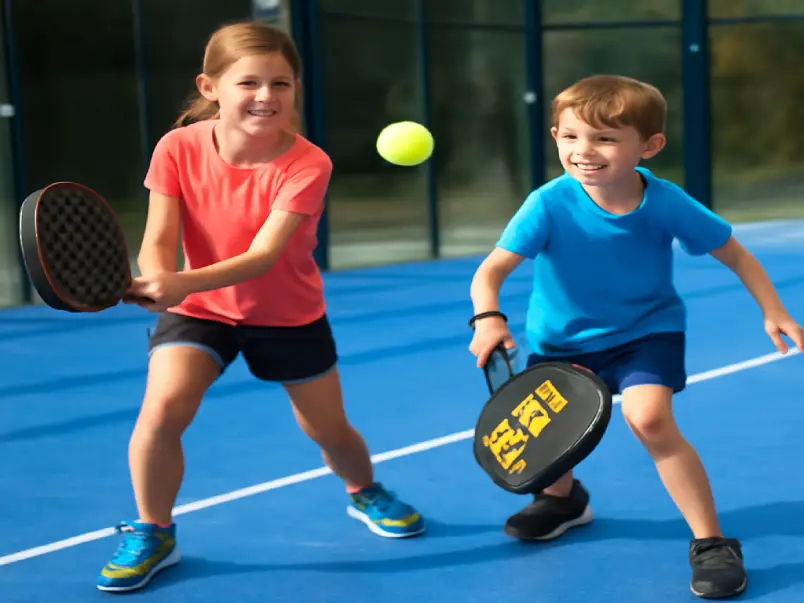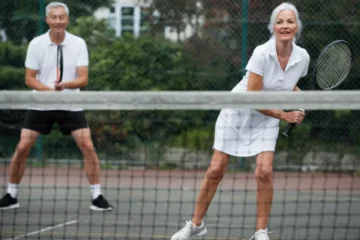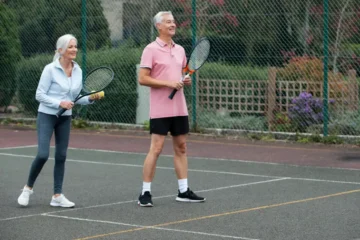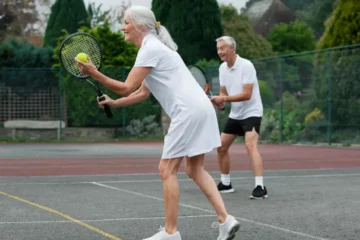Padel is rapidly growing in popularity worldwide, especially among children. From Europe to Latin America, families are discovering how fun and accessible this dynamic sport is, quickly becoming a go-to activity for kids of all ages. But what is it about padel that makes it so appealing? Why is it becoming one of the fastest-growing sports for children?
Padel is a unique blend of tennis and squash, making it an ideal choice for kids looking to get active, learn new skills, and have fun in a social, supportive environment. Played on an enclosed court with walls, it requires less space and is easier to pick up than traditional racket sports. It’s a game that emphasizes teamwork, strategy, and physical activity in a way that’s both challenging and enjoyable.
In this article, we will dive into why padel is an excellent sport for kids, focusing on its physical, social, and mental benefits. We’ll also provide practical tips for parents to help get their children started, including how to find the right padel program and what to expect from lessons.
II. What is Padel? A Kid-Friendly Explanation
Think of padel as a cross between tennis and squash, with its own exciting twist. Played on a smaller court surrounded by walls, it is easier to learn and more accessible for younger players compared to sports like tennis or squash. Here’s a breakdown of what makes padel unique:
Key Equipment:
- The Padel Racket: Unlike a traditional tennis racket, the padel racket is solid with no strings, making it more forgiving for young players. It’s also smaller and lighter, making it easier for kids to handle.
- The Ball: Similar to a tennis ball, but with a bit less pressure, making it slower and easier to control.
- The Court: Padel is played on a smaller, enclosed court with glass and metal mesh walls that are an integral part of the game. Players can hit the ball off the walls, creating a unique, fast-paced dynamic.
Basic Rules:
- The game is typically played in doubles (two players per team).
- The ball must bounce once on the ground before hitting the wall.
- Players serve underhand, and the ball must land in the opposite service box.
- The objective is to win points by making the ball land within the opponent’s court area or hitting the walls in a strategic way.
A Fun and Quick Learning Curve:
Padel is a beginner-friendly sport, especially for kids. The compact court size and smaller ball make it easier to return shots and enjoy the game right from the start, unlike tennis, which often requires more technical skills to hit the ball properly.
III. Why Choose Padel? The Top 5 Benefits for Kids
1. Physical Development & Health
Padel offers a range of physical benefits for kids. It is a full-body workout that engages both the upper and lower body, making it excellent for developing coordination, agility, and stamina.
- Cardiovascular Health: The quick bursts of movement help improve heart health and endurance.
- Gross Motor Skills: Padel strengthens large muscle groups and improves balance and coordination.
- Reflexes and Spatial Awareness: With the added complexity of the walls, kids learn to react quickly and develop better hand-eye coordination.
Additionally, padel is a low-impact sport, meaning it is easier on the joints, making it suitable for children of all ages. It’s a great way for kids to stay active without the wear-and-tear typically associated with other sports.
2. Social Skills & Teamwork
As a doubles game, padel is all about communication, teamwork, and strategy. Kids learn to work with a partner, which helps them develop important social skills:
- Communication: Effective communication is key to winning in padel, as players need to coordinate their movements and shots.
- Cooperation and Support: Padel teaches children how to support each other, celebrate victories, and handle losses gracefully.
- Making Friends: With its social nature, padel provides ample opportunities for children to meet others and make lasting friendships in a relaxed, fun environment.
3. Mental & Cognitive Growth
Padel isn’t just physically engaging—it also challenges kids mentally, helping them develop critical thinking and problem-solving skills.
- Tactical Thinking: Kids must think on their feet, analyzing the game and deciding whether to play offensively or defensively.
- Concentration and Focus: To successfully return a shot or make a strategic play, kids need to stay focused on the game and anticipate their opponents’ moves.
The mental aspect of the game promotes cognitive growth, teaching kids how to make decisions under pressure and develop their strategic thinking abilities.
4. Accessibility & Quick Learning Curve
One of the best aspects of padel is how accessible it is for children. Unlike tennis, which can be more challenging to learn due to the skill required to hit the ball properly, padel offers a much quicker learning curve. Children can pick up the sport and start playing quickly, making it an ideal entry point into racket sports.
This easy start not only boosts confidence but also helps children feel a sense of achievement early on. The inclusive nature of padel also makes it suitable for children of varying athletic abilities, from beginners to more advanced players.
5. Fun and Enjoyment
At its core, padel is fun. The fast-paced nature of the game, combined with the use of the walls, creates a dynamic, engaging experience. Unlike some traditional individual sports, where there may be more pressure to win, padel maintains a light-hearted atmosphere. This makes it particularly appealing for kids, who are more likely to stay engaged when they are having fun.
IV. Finding the Right Padel Program for Your Child
What to Look For in a Kids’ Padel Program:
When selecting a padel program for your child, consider the following factors to ensure a positive and supportive experience:
- Qualified Coaches: Look for instructors with experience working with kids and a solid understanding of child development. A good coach should be able to teach the fundamentals while keeping the experience fun and engaging.
- Age-Appropriate Groups: It’s essential that the program groups children by age and skill level to ensure that they’re learning alongside peers with similar abilities. Programs may have specific groups for different age ranges, such as 5-7, 8-10, and 11+.
- Focus on Fun & Fundamentals: Especially for beginners, the primary goal should be to introduce padel in a way that emphasizes enjoyment over competition. Look for a program that prioritizes skill development and fosters a positive environment.
- Proper Equipment: The program should provide child-sized rackets and balls that are specifically designed for young players. If your child is new to the sport, some programs offer the option to rent equipment.
- Safe Environment: The club or program should provide a welcoming, supportive atmosphere where kids can learn without pressure. Safety is also crucial, so ensure that the facility adheres to safety standards for young players.
Types of Padel Programs Available:
- Taster Sessions / Introductory Clinics: These are short, low-commitment programs that offer a chance for your child to try out the sport before committing to regular lessons.
- Weekly Group Lessons: A common option for ongoing skill development, these lessons are typically structured to progressively build your child’s abilities.
- School Clubs & After-School Programs: Many schools now offer padel as part of their after-school activities. These programs are an excellent way to introduce your child to the sport in a familiar, low-pressure setting.
- Private or Semi-Private Lessons: If your child thrives on individual attention or requires a more personalized approach, private or semi-private lessons can be a great option.
- Holiday Camps & Intensive Workshops: During school breaks, padel camps provide an opportunity for kids to improve their skills in a more immersive, focused environment.
V. A Parent’s Checklist: Getting Your Child Started
Here’s a simple checklist to help you get your child started in padel:
- Find a Local Padel Club: Start by searching for padel clubs or facilities near you. Use search terms like “kids’ padel lessons near me” or “padel clubs for children.”
- Inquire About Trial Lessons: Many clubs offer introductory classes or trial lessons, allowing your child to experience the sport before committing.
- Ensure They Have the Right Gear: Your child will need comfortable sports clothes and proper footwear (court shoes are ideal). Most clubs provide equipment for beginners, but it’s worth checking if they have kid-sized rackets available to rent.
- Emphasize Fun Over Winning: The key to a positive experience is to focus on the fun aspects of the sport, not just the competition. Remind your child that it’s about enjoying the game and trying their best.
- Get Involved: After your child’s lesson, ask them about what they enjoyed most. Showing interest in their experience can help reinforce their enjoyment of the sport.
VI. Addressing Common Parental Concerns
Is it Safe?
Padel is a low-impact sport, making it safe for kids. The court’s enclosed nature means that there are fewer opportunities for accidents, and the ball is softer than a traditional tennis ball, reducing the risk of injury.
Is it Expensive?
Padel is relatively affordable compared to other junior sports like tennis or soccer. While some equipment is needed (such as a racket and shoes), many clubs offer rental options for beginners, keeping the costs down.
My Child Has Never Played Racket Sports. Is That Okay?
Absolutely! Padel is an ideal sport for beginners. The learning curve is short, and children can quickly start enjoying the game without needing prior experience in other racket sports.
VII. Conclusion: Serving Up a Lifetime of Sport
Padel is more than just a fun activity—it’s an excellent way for children to develop physically, socially, and mentally. With its easy learning curve, dynamic gameplay, and emphasis on teamwork, padel provides kids with the skills and confidence they need to stay active and engaged.
FAQs: Padel for Kids
1. What age is suitable for children to start playing padel?
Padel is suitable for kids as young as 5 years old. Many clubs offer beginner classes for young children, and programs are typically tailored for different age groups, such as 5-7, 8-10, and 11+.
2. Is padel safe for kids?
Yes, padel is a low-impact sport that is generally considered safe for kids. The enclosed courts and soft balls reduce the risk of injury, and the sport focuses on fun and teamwork rather than intense competition.
3. How difficult is it for kids to learn padel?
Padel is relatively easy for kids to learn compared to other racket sports like tennis. The smaller court, softer ball, and simpler rules make it beginner-friendly, and many children enjoy the fast-paced nature of the game right from the start.
4. Do kids need special equipment for padel?
While some padel clubs provide equipment for beginners, children will need comfortable sports clothing, court shoes, and a kid-sized racket. Some clubs offer racket rentals, making it easy for beginners to get started without purchasing their own gear initially.
5. How can I find a padel program for my child?
Start by searching for local padel clubs or facilities that offer youth programs. Many clubs offer trial lessons, introductory clinics, or after-school programs to help your child try out the sport. Look for a program that focuses on fun, age-appropriate coaching, and a supportive environment.
6. What are the benefits of padel for kids?
Padel provides numerous benefits, including improved cardiovascular health, better coordination and agility, enhanced teamwork skills, and cognitive development. It also offers a fun and social way for kids to stay active and build confidence.
7. How much does it cost to play padel?
The cost of playing padel can vary depending on the location, program type, and equipment needs. Many clubs offer rental equipment and introductory lessons that make the sport affordable for beginners. It is generally more affordable than other junior sports like tennis or soccer.




